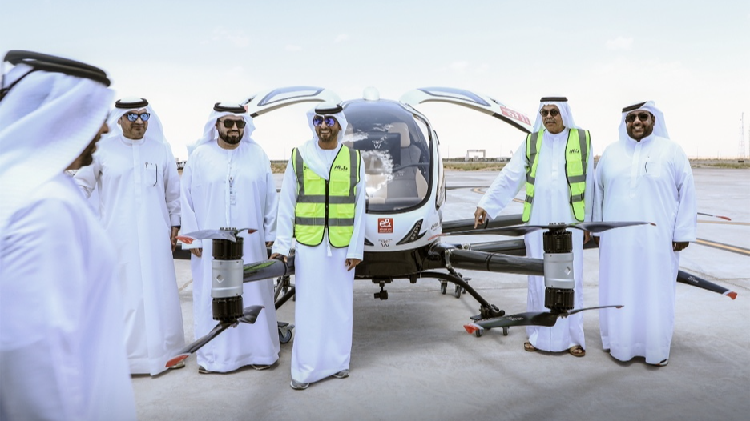Middle East Insights: Gulf nations embrace low-altitude economy


Editor’s note: Middle East Insights is a special feature series by China Media Group (CMG) – Middle East station, offering a comprehensive analysis of pivotal regional issues spanning politics, economics, culture and other fields in the area. This is the first article in a series of observations on the development of low-altitude economy in the Gulf region and cooperation between Chinese companies and local partners.
<img src='https://news.cgtn.com/news/2024-07-23/Middle-East-Insights-Gulf-nations-embrace-low-altitude-economy-1vsO258GzzG/img/9997c2405971479aaef6174823f9d00c/9997c2405971479aaef6174823f9d00c.png' alt='A view of Palm Island seen from an aircraft. /CFP'
The journey from Dubai International Airport to the iconic Palm Jumeirah usually takes 40 minutes by car. By 2026, this 40-kilometer trip is expected to be reduced to just 10 minutes, thanks to a new mode of transportation straight out of a sci-fi movie: air taxis.
Passengers will be able to book this service online and travel to destinations at altitudes of 500 to 1,000 meters.
Once a futuristic concept in novels and movies, flying over city skylines in low-altitude aircraft is becoming a reality in the Gulf countries. As these nations develop their low-altitude economies, Chinese enterprises are seizing the opportunity, becoming active participants in driving local industrial growth.
Gulf nations embrace low-altitude economy
In recent years, Gulf countries have introduced national development strategies such as Saudi Arabia’s “Vision 2030,” the UAE’s “We the UAE 2031,” and Qatar’s “National Vision 2030.” The aim is to transform their economies from energy dependency to diversification, focusing on technological innovation, smart city development, and sustainable growth.
Low-altitude aerospace technologies, such as electric vertical takeoff and landing (eVTOL) aircraft, characterized by their intelligence, efficiency, and eco-friendliness, align well with the market needs of Gulf countries. As a result, the low-altitude economy has become a competitive and innovative field in the region.
<img src='https://news.cgtn.com/news/2024-07-23/Middle-East-Insights-Gulf-nations-embrace-low-altitude-economy-1vsO258GzzG/img/b4acbc42eaa0484897f55f8cf2e8779a/b4acbc42eaa0484897f55f8cf2e8779a.png' alt='As early as 2017, Dubai began exploring the use of autonomous manned aircraft for air taxi services. /CFP'
The UAE is leading the region in the low-altitude sector. Dubai, a city dedicated to future urban planning, launched the “Dubai Horizon” project in 2022. This initiative focuses on planning low-altitude flight routes and drone landing points, with the first phase completed in 2023. The city is aiming to introduce air taxi services by 2026.
In April, the UAE’s General Civil Aviation Authority gave Abu Dhabi the green light to launch the country’s first micro-airport designed specifically for electric vertical takeoff aircraft. Another emirate, Ras Al Khaimah, is also collaborating with tech companies to start commercial air taxi operations by 2027, aiming to enhance local tourism infrastructure with eVTOL services for inter-site transportation.
Saudi Arabia is also actively engaging in this sector. It has committed $100 billion in investments by 2030 to support both traditional aviation and low-altitude industries like drones and eVTOL aircraft.
Saudi Arabia is also integrating the air taxi concept into its ambitious NEOM project, having ordered 15 eVTOL aircraft from a German company and invested $175 million in 2022 for further strategic collaboration. The country plans to have a fleet by 2025 and develop diverse low-altitude flight modes in NEOM.
This year, Qatar’s Ministry of Transport announced plans to test electric air taxis by early 2025 and has begun applying for test flight permits with domestic agencies.
The internal drive for economic transformation, national policy direction, the demand of a growing market, and strong economic power are key factors attracting low-altitude economy enterprises to the Gulf region.
He Tianxing, vice president of China’s leading eVTOL manufacturer EHang, told CGTN that the Gulf region boasts a high level of economic development, a favorable investment environment, and a strong foundation for adopting and developing high-tech innovations.
“The region has a strong market demand and industrial desire for advanced air transportation that is safe, efficient, convenient, and environmentally friendly, making it an ideal area for creating and developing new application scenarios,” he said.
<img src='https://news.cgtn.com/news/2024-07-23/Middle-East-Insights-Gulf-nations-embrace-low-altitude-economy-1vsO258GzzG/img/84c3be98152c4d0daffe8a1ae84106d1/84c3be98152c4d0daffe8a1ae84106d1.png' alt='NEOM is a project focusing on nine key industries, including energy and water, biotechnology, food, advanced manufacturing, and entertainment, with a core project being the "Mirror Line," a super tall skyscraper. /Photo courtesy of NEOM '
Leveraging strengths in cooperation
The low-altitude manufacturing sector is a key focus for Chinese companies expanding overseas.
The Gulf region, with its vast lands and relatively low population density, features scattered urban and rural areas and extensive desert zones, coupled with harsh climate conditions. These characteristics create an ideal application environment for low-altitude aircraft such as drones.
For instance, in oil and gas pipeline inspections, drones are resilient to the Gulf’s hot weather and can operate in a safe and stable way in remote deserts. Additionally, manufacturing companies can offer customized services based on client needs. Drones equipped with navigation, positioning, and camera functions significantly enhance inspection efficiency while maintaining relatively low operational costs.
So far, several Chinese technology companies, including EHang, Shanghai Fengfei, XPeng Huitian, and Yufeng Future, have entered the Gulf market. Their products are applied across various sectors such as air transportation, logistics, firefighting, emergency rescue, and pipeline inspections.
Leveraging domestic industrial chain advantages and innovative technologies, Chinese companies are also exploring collaboration models better suited to the regional market.
Overseas companies provide complete systems and technical support based on local client needs, while local firms handle low-altitude operations, including route applications, approvals, and pilot management.
According to one industry insider, this collaborative model not only creates more job opportunities but also helps Chinese companies expand their local client base. “Such cooperation effectively empowers both parties, achieving a win-win outcome,” he said.
<img src='https://news.cgtn.com/news/2024-07-23/Middle-East-Insights-Gulf-nations-embrace-low-altitude-economy-1vsO258GzzG/img/182de0c7316d4bd882d2f311eb6d4064/182de0c7316d4bd882d2f311eb6d4064.png' alt='In May 2024, board members of the Multi-Level Group experienced the first manned flight test of a Chinese-developed eVTOL aircraft in Abu Dhabi, the UAE. /Photo courtesy of Ehang'
Multiple Chinese companies have already established partnerships with local firms in the UAE and other Gulf countries. In April, EHang signed a cooperation agreement with the Multi-Level Group and the Abu Dhabi Investment Office.
The company plans to set up a regional headquarters in Abu Dhabi and collaborate with local partners on production, flight operations, R&D, training, maintenance, and overhauls, according to its vice president.
Several entities from the UAE and Saudi Arabia have signed procurement contracts with Chinese firms for eVTOL aircraft, and further cooperation in areas such as aircraft battery charging and vertical takeoff and landing infrastructure is also expanding.
Global investors are also closely monitoring the development prospects of Chinese companies specializing in low-altitude economy technology in the Gulf region. In March, China’s Shidi Technology secured $20 million in Series A funding from international investors to advance its air taxi development in the Middle East.
In April, Shenzhen Urban Transportation Planning and Design Research Center Co., Ltd. revealed to investors that it will soon launch low-altitude economy operations in the Middle East. This includes designing low-altitude economy solutions and developing related platforms.
As China’s low-altitude economy continues to grow, not only manufacturing exports but also other sectors within the industry chain are increasingly expanding internationally.
Supervisor: Mu Li
Producer: Li Chao
Reporter: Wang Xuejing





